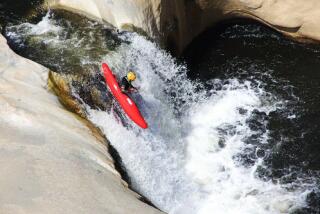Deaths of 3 Youths Spotlight Alcohol Abuse
- Share via
RONAN, Mont. — When 11-year-olds Frankie Nicolai III and Justin Benoist turned up dead in a snowy field after guzzling huge amounts of vodka, it fell on Lake County Sheriff Bill Barron to retrieve the boys’ frozen bodies.
For Barron, the unpleasant task was compounded by a similar incident three months earlier when Justin’s older brother, Tyler Benoist, 14, was found drunk and dead in a burned trailer on another part of the Flathead Indian Reservation.
Tyler died of smoke inhalation. His kid brother, with a blood-alcohol level of 0.20%, died of alcohol poisoning and hypothermia. Frankie, whose body was in the field about 100 yards from Justin’s, died of alcohol poisoning, his blood-alcohol level a lethal 0.50% -- more than six times the level defining drunken driving in Montana.
The deaths, two in this community of 2,800 and the other a few miles away in Pablo, have people searching for explanations. The seemingly senseless loss of the three young American Indians also has intensified the spotlight on alcohol abuse in Indian country.
The alcohol-related death rate for Indians is about seven times the U.S. rate for all races combined, according to the federal Indian Health Service. But residents, educators and law enforcement authorities say the deaths of Justin and Frankie cannot be blamed on any one thing -- and especially not on a stereotype of Indian life.
“It was a breakdown of everything -- the families, the school, the community,” customer Heather Davies said as some coffee regulars gathered at the New Moon Cafe in Polson, the county seat on the southern shore of Flathead Lake, north of Ronan.
Underage drinking is a problem throughout society, said Steve Wing, a policy analyst for the federal Substance Abuse and Mental Health Services Administration in Rockville, Md. “Some parents just don’t realize how dangerous it can be.”
In Montana, a statewide survey by the Office of Public Instruction last year found that 15% of seventh- and eighth-graders said they had been binge-drinking in the previous month. Sixty-one percent said they’d had a drink at some time in their lives.
Next month, the Substance Abuse and Mental Health Services Administration and the Scholastic publishing company will send packets of information to youngsters nationwide, intended to discourage them from drinking. The packets are designed for fifth-graders, children a year younger than Justin and Frankie.
“The age of initiation, the first drink, has been going steadily down. It’s now around 11 or 12 years old, and girls are pretty much the same as boys,” said Richard Yoast, director of an underage drinking project run by the American Medical Assn. and funded by the Robert Wood Johnson Foundation.
In Montana, state Sen. Duane Grimes (R-Clancy) believes that the rate of underage drinking has a lot to do with how alcohol is viewed by adults in the state.
“There is a drinking culture that goes with our cowboy mentality,” said Grimes, who served as chairman of a special committee on substance abuse in Montana, a state that ranks fourth in juvenile drinking. “Someday it has to change. I don’t know how many tragedies it’s going to take.”
In Helena, nearly 200 miles from Ronan, middle-school science teacher Tony Smith recognized the boys’ deaths as something he needed to address with his eighth-graders, nearly all of them white.
Smith set aside his usual lesson plan to talk -- again -- to the class about what alcohol does to the chemistry of the human body.
“I tell them there are choices in life, and you have to be educated about these things,” he said.
He also talked about the double tragedies in the Benoist family, telling his students: “Here are parents who buried two of their sons in a matter of months.”
Hundreds of mourners attended Frankie and Justin’s funeral in a simple community hall just off the highway that takes travelers through the sprawling natural beauty of northwestern Montana’s Flathead Valley. Glacier National Park and the popular ski town of Whitefish are a short drive north beyond Flathead Lake and the shadow of the Mission Mountains, past well-pruned family cherry orchards and outside the reservation boundaries.
The reservation, home to the Confederated Salish and Kootenai Tribes, is a mix of haves and have-nots. More than half of the population is non-Indian, and some towns within the reservation, such as Polson, seem vibrant. Main Street is busy, tourists are plentiful during the summer and lakefront homes carry hefty prices.
The unemployment rate in Lake County, two-thirds of which is within reservation boundaries, is far less than the rates of other Montana counties that lie within reservations.
But Lake County’s unemployment rate is still above the state average, and usually among the highest of the most populous counties in the state. At Ronan Middle School, where Frankie and Justin were sixth-graders, 55% of the children qualify for lunch free or at reduced prices through a government program. The state figure is 34%.
Barron said he found underage drinking a constant problem, but one he knew was an issue for law enforcement and social services officials throughout Montana.
Compounding it are parents who sometimes make light of juvenile drinking. Barron recalled one mother’s response when her young son was taken home after being caught drunk.
“The mom whacks him upside the head and says, ‘What have I told you about drinking on school nights?’ ” Barron said.
Officials here and elsewhere in Montana also say some parents take a soft view of juvenile drinking when they consider the perils of drugs such as methamphetamine. The parental reaction: “Thank God it’s not meth.”
“There is no question meth is more addictive and will consume a life quickly,” Grimes said. “But part of the meth problem is a lax attitude toward alcohol.”
Besides the alcohol issue, there has been a public outcry over the time -- three days -- between when Justin and Frankie skipped Friday afternoon classes at school and the discovery of their bodies in the field.
Tribal police said Justin’s mother reported him missing Feb. 26. But he showed up for school the next morning, stayed until about 1:25 p.m. and was not reported missing again before his body was found March 1, police said. Frankie’s father called authorities and reported his disappearance the night of Feb. 27.
Frankie and Justin’s parents have not spoken publicly about the deaths, and efforts to reach them by telephone were unsuccessful.
Barron, who described both 11-year-olds as slight for their age, is investigating whether an adult supplied the liquor that poisoned them.
Salish-Kootenai tribal officials issued a statement saying they planned a full internal investigation of the tragedies, but did not return repeated calls seeking more information.
“We assume they are making the interventions that are [necessary],” said Dr. Kathleen Masis, acting chief medical officer at the Indian Health Service’s area office in Billings. Masis said the agency had not been asked to assist in the investigation by the tribal government, which receives IHS money to operate health services.
Like schools nationwide, the one that Frankie and Justin attended has a program designed to discourage alcohol use. Ronan Middle School Principal George Heaton said after the deaths that the staff would look at revising the instruction in a way that “drives the story home more, arising from this.”
A tribal flag hangs inside the school’s entryway, where 53% of the students are American Indians. For Heaton, the entire student body is the focus when he talks about drinking.
“Alcohol is an issue for all young people,” he said.
More to Read
Sign up for Essential California
The most important California stories and recommendations in your inbox every morning.
You may occasionally receive promotional content from the Los Angeles Times.













